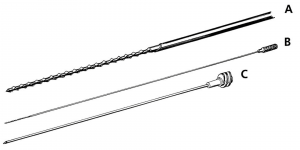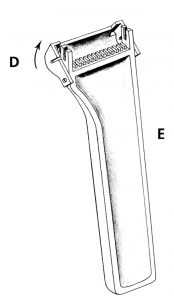Construction of the instrument
The screw needle (fig.B) is made of a 0.55 mm thick stainless steel rod with a small handle at its proximal end. The distal 16 mm of the rod have been formed into a tapering screw with cutting ridge (Fig. A). The needle is housed in a steel cannula with an outer diameter of 0.8 (equivalent to 21 gauge needles), respectively.
The length of the cannula (Fig. C) matches that of the screw needle. Despite its small diameter, the screw needle with the 0.8 mm cannula is sufficiently stiff to be inserted for sampling of cellular material from tissue.
The plastic hub of the cannula has the shape of a helical screw, which fits into the teeth of the accompanying instrument holder (Fig. E). The screw needle and cannula are held in place by the instrument holder’s hinged lock (Fig. D). The instrument is inserted with the screw needle in a protected position in the cannula. The screw needle is also positioned in the cannula at the withdrawal of the instrument. The risk of seeding surrounding tissues with cellular material from the screw needle during withdrawal of the instrument is thereby reduced to a minimum.
The screw needle and cannula are delivered in standard packs of 20 instruments, each in individual protective packaging, sterilized and ready for use. They are disposable and intended for single use to ensure efficient sampling, sterility and indisputable security against any kind of accidental inoculation. The instrument holder, which is made of polycarbonate, is intended for repeated use. The instrument holder is not intended to be sterilized by user, but recommend to be rinsed in alcohol between use. Each standard pack of 20 instruments includes two instrument holders. The instrument is available in other standard dimensions according to our ordering information.

